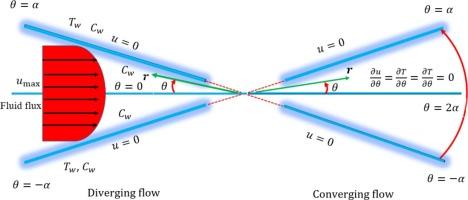Jeffrey-Hamel flow with heat and mass transfer characteristics of Jeffrey Nanofluid in a diverging-Converging Channel
IF 4.2
Q2 CHEMISTRY, MULTIDISCIPLINARY
引用次数: 0
Abstract
The flow with heat and mass transfer features of viscoelastic fluid in narrow diverging-converging channels have significant applications in polymer processing in convergent dies, and microfluidic devices like nozzles and Jet designs. The objective of this research is to examine the magnetohydrodynamics (MHD) Jeffrey-Hamel flow (JHF) with heat and mass transfer characteristics using well-known Buongiorno model and thermal radiation. The velocity slip, MHD, viscous dissipation, thermophoresis, Brownian motion, and thermal radiation are all included in the governing equations. The resulting coupled nonlinear boundary value problem is solved numerically using the Bvp4c method. The findings shows that the wall slip uplift velocity in convergent channel because of favorable pressure gradient which decreases the skin friction. The influence of relaxation to retardation time due to stress tensor of viscoelastic Jeffrey fluid shows conflicting behavior in both channel. The temperature profile is more sensitive to radiation, fluid parameter, Brownian, thermophoresis and viscous dissipation in divergent channel. The concentration of nanoparticles decreases with increasing Deborah number. The divergent channel exhibit higher Nusselt and Sherwood number than convergent section. The findings of this study are crucial for improving viscoelastic fluid flow in industrial systems where heat and mass transfer occur in a narrow geometries.

Jeffrey纳米流体在发散-收敛通道中传热传质特性的Jeffrey- hamel流动
粘弹性流体在狭窄的发散-收敛通道中具有传热传质特性的流动在聚合模具中的聚合物加工以及喷嘴和射流等微流体装置的设计中具有重要的应用。本研究的目的是利用著名的Buongiorno模型和热辐射研究具有传热传质特性的磁流体动力学(MHD) Jeffrey-Hamel流(JHF)。控制方程中包括速度滑移、MHD、粘性耗散、热泳动、布朗运动和热辐射。采用Bvp4c方法对得到的耦合非线性边值问题进行了数值求解。结果表明:由于有利的压力梯度,收敛通道壁面滑移抬升速度增大,减小了表面摩擦力;粘弹性杰弗里流体的应力张量引起的弛豫对延迟时间的影响在两个通道中表现出冲突的行为。温度分布对辐射、流体参数、布朗运动、热泳运动和发散通道的粘性耗散更为敏感。纳米粒子的浓度随底波拉数的增加而降低。发散通道的Nusselt和Sherwood数高于收敛通道。本研究的发现对于改善工业系统中的粘弹性流体流动至关重要,其中传热和传质发生在狭窄的几何形状中。
本文章由计算机程序翻译,如有差异,请以英文原文为准。
求助全文
约1分钟内获得全文
求助全文

 求助内容:
求助内容: 应助结果提醒方式:
应助结果提醒方式:


